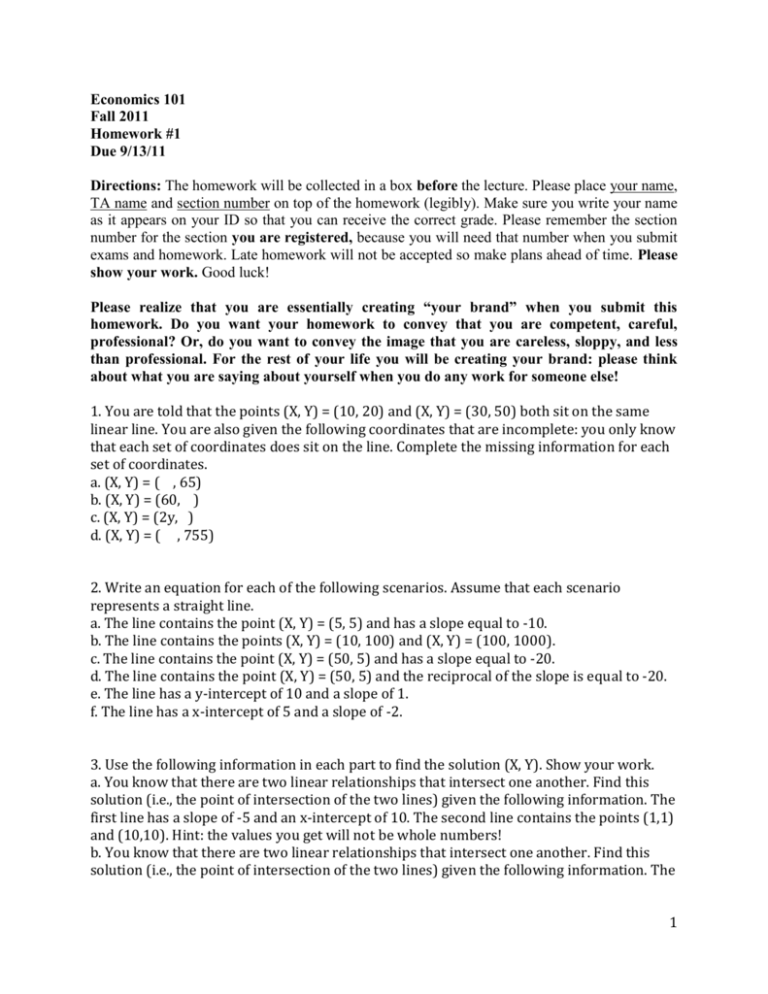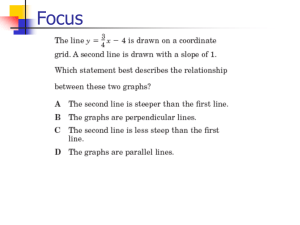Homework #1
advertisement

Economics 101 Fall 2011 Homework #1 Due 9/13/11 Directions: The homework will be collected in a box before the lecture. Please place your name, TA name and section number on top of the homework (legibly). Make sure you write your name as it appears on your ID so that you can receive the correct grade. Please remember the section number for the section you are registered, because you will need that number when you submit exams and homework. Late homework will not be accepted so make plans ahead of time. Please show your work. Good luck! Please realize that you are essentially creating “your brand” when you submit this homework. Do you want your homework to convey that you are competent, careful, professional? Or, do you want to convey the image that you are careless, sloppy, and less than professional. For the rest of your life you will be creating your brand: please think about what you are saying about yourself when you do any work for someone else! 1. You are told that the points (X, Y) = (10, 20) and (X, Y) = (30, 50) both sit on the same linear line. You are also given the following coordinates that are incomplete: you only know that each set of coordinates does sit on the line. Complete the missing information for each set of coordinates. a. (X, Y) = ( , 65) b. (X, Y) = (60, ) c. (X, Y) = (2y, ) d. (X, Y) = ( , 755) 2. Write an equation for each of the following scenarios. Assume that each scenario represents a straight line. a. The line contains the point (X, Y) = (5, 5) and has a slope equal to -10. b. The line contains the points (X, Y) = (10, 100) and (X, Y) = (100, 1000). c. The line contains the point (X, Y) = (50, 5) and has a slope equal to -20. d. The line contains the point (X, Y) = (50, 5) and the reciprocal of the slope is equal to -20. e. The line has a y-intercept of 10 and a slope of 1. f. The line has a x-intercept of 5 and a slope of -2. 3. Use the following information in each part to find the solution (X, Y). Show your work. a. You know that there are two linear relationships that intersect one another. Find this solution (i.e., the point of intersection of the two lines) given the following information. The first line has a slope of -5 and an x-intercept of 10. The second line contains the points (1,1) and (10,10). Hint: the values you get will not be whole numbers! b. You know that there are two linear relationships that intersect one another. Find this solution (i.e., the point of intersection of the two lines) given the following information. The 1 first line has a slope of 10 and a y-intercept of 2. The second line contains the point (2,118) and has a slope of -2. c. You know that there are two linear relationships that intersect one another. Find this solution (i.e., the point of intersection of the two lines) given the following information. The first line has a slope of -10 and contains the point (100, 100) and the second line has a slope of 20 and contains the point (10, -200). 4. Suppose you are taking a chemistry class that has four exams of equal weight. To make this problem simpler let’s assume that each exam has 100 possible points. Suppose you make a 73 on the first exam, a 80 on the second exam and a 60 on the third exam. a. The mean is what is known as the simple average: to find the mean in this example you would simply sum the scores of the exams and then divide by the number of exams. What is the mean given the above information? Show your work to arrive at your final answer. b. Suppose on the fourth exam you make a score of 75. Without doing any computation what do you predict will happen to your average in the class given this score? c. Suppose you have not taken the fourth exam yet but you know that to get a B in the class you must have an average of 80 points. What is the minimum score you can receive on the fourth exam and still earn a B in the class? If each exam is 100 points, can you earn a B in this class? Show your work to arrive at your final answer. d. Suppose you have not taken the fourth exam yet but you know that to get a B in the class you must have an average of 75 points (the professor has decided to use a more generous scale for the class grade distribution). What is the minimum score you can receive on the fourth exam and still earn a B in the class? Show your work to arrive at your final answer. 5. You are taking a math class and there are four exams in the class that will determine your grade. The exams are all given equal weight in determining your grade but unfortunately for you they all have different numbers of total points. The first exam had forty points and you made a thirty on this exam. The second exam had fifty points and you made a forty on it. The third exam had sixty points and you made a 48 on it. You have not yet taken the fourth exam. a. Given you three exam scores, what scores did you make on each of these exams if each of them had been graded on a 100 point scale? Show the work you did to find your answers. b. What is your average on a 100 point scale in your math class after these first three exams? c. Suppose you need to have an average of 80 points on a 100 point scale in order to earn an B in the class. What score must you make on the fourth exam if the fourth exam has a total of 50 possible points? d. Can you think of any reason(s) for why the professor might have exams that have equal weight in the determination of your grade but where each exam is given a different number of possible points. Discuss your answer using complete sentences as well as paragraphs (that is, write an organized essay for this question!). 2 6. Suppose that you know that the relationship between X and Y is initially given by the equation Y = 2X + 10. Then, you are told that for every Y value the value of X has now increased by 50 units. Write the equation for the new line given this information. 7. Suppose that you know that the relationship between X and Y is initially given by the equation Y = -2X + 5. Then, you are told that for every Y value the value of X has now decreased by 10 units. Write the equation for the new line given this information. 8. Joey has $100 that he deposits in his bank account. He earns 5% interest a year on this account. Assume Joey is not going to remove his money from the bank for at least 4 years. a. How much money does he have after the first year? b. What was the percentage increase in money that Joey experienced between the initial point and the end of the first year? c. How much money does he have after the second year? d. What was the percentage increase in money that Joey experienced between the first year and the second year? e. How much money does he have after the third year? f. How much money does he have after the fourth year? g. What was the percentage increase in money that Joey experienced between the initial point and the end of the fourth year? 3




